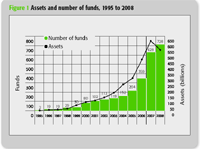Finances: What you need to know about Exchange Traded Funds
An exchange-traded fund can offer an inexpensive way to diversify an investment portfolio.

Key Points

Like closed-end funds, ETFs can be traded on a secondary market and thus have a market price that may be higher or lower than their net asset value (NAV). The NAV is the total value of a fund's assets less the liabilities. If the ETF shares trade at a price above their NAV, then they are said to be trading at a premium. Conversely, if they are trading at a price below their NAV, then they are said to be trading at a discount.
Typically, ETFs track stock indexes and are offered through a variety of well-known companies, including Standard & Poor's, Dow Jones, Vanguard, Merrill Lynch, and Barclays. The oldest and biggest ETF, Standard & Poor's Depositary Receipts (SPDRs, pronounced "spiders") tracks the S&P 500 index. It began trading on the American Stock Exchange under the symbol SPY. Because exchange-traded funds track specific indexes, their price fluctuates with the performance of the index. The companies and ETFs discussed herein are for illustrative purpose only and not a recommendation for the purchase of those specific securities.
ETFs track a wide variety of market indexes, the most prominent being equity indexes. ETF funds also include fixed-income securities, commodities, and currencies, and they cover both domestic and international indexes. In addition, exchange-traded funds may be based on certain characteristics such as market capitalization (small-, large-, and mid-cap stocks) or investment styles such as growth, value, and blend.
ETFs can be used to diversify across different sectors such as health care, technology, real estate, and utilities. Some ETFs track certain characteristics such as dividend-paying stocks. For example, ETFs may track a group of securities that have a number of consecutive years of dividend growth. Another variation may be an ETF that tracks an index that consists of the 100 highest-yielding stocks with dividends that are equal to or greater than dividends paid 5 years ago. Some ETFs permit shareholders to reinvest their dividends to purchase additional ETF shares.
A fast-growing investment vehicle
Innovative offerings have made ETFs one the fastest-growing investment vehicles in the financial industry. ETFs are a popular investment choice among both active and passive investors because of their flexibility to trade like a stock and instant diversification in the form of an index fund. Keep in mind that diversification does not eliminate the risk of investment losses.
The U.S. market accounts for the largest volume of ETFs in the world. Figure 1 illustrates the increase in the number and total assets of exchange-traded funds since 1995. Due to an increasing demand from investors in recent years, ETF assets have nearly doubled every 2 years. In 2008, the total number of ETFs rose to 728, with assets worth about $531 billion.